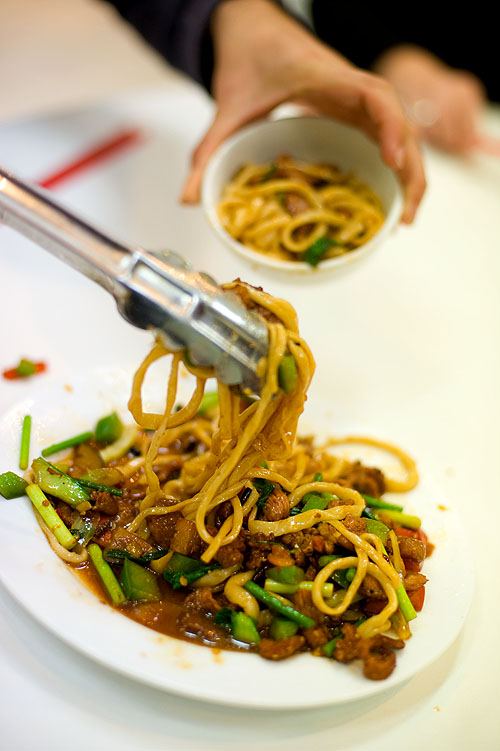 In a good way, of course.
In a good way, of course.
It only took me a couple of meals and a bit of exploring to come to the conclusion that Melbourne must be one of the best food cities, well, anywhere. The diversity of cuisine alone is astounding: authentic Vietnamese, Ethiopian, Lebanese, Chinese, Greek and Italian are all easily available. The city's markets are fantastically well-stocked and vibrant. The coffee excellent. And there are meat pies. The only downside I can think of is cost, but this is largely based on my parsiminous Bangkok mindset, and reckon you're more likely to find tastier and more varied budget eats in Melbourne than say, New York City or Paris.
I was fortunate enough to eat at two of the city's upscale restaurants, Cutler & Co. and MoVida. We had a wonderful meal at the former, which had one of the most interesting dessert menus I've ever come across. Now, I'm normally not much of a sweets fan, but with creative and delicious sounding dishes as Ginger granita, coconut sorbet, fresh lychee; Toffee apple, fromage blanc, spiced short bread & cider jelly; Steamed pear & suet pudding, liquorice ice cream, confit lemon; and Chestnut ice cream, burnt butter cake, frozen chocolate crumbs & Cognac, ordering dessert was an imperative, not an option. My Chocolate ice cream sandwich, vanilla parfait & salted caramel was wonderful, but then again, I'd probably be happy with a plate of warm dirt as long as it was topped with salted caramel.
Cutler & Co.
55-57 Gertrude Street, Fitzroy, Melbourne
03 9419 4888
www.cutlerandco.com.au
MoVida is a ridiculously popular tapas restaurant that normally requires reservations months in advance, but we were lucky enough to be able to slip in just before the place filled up on a wet and cold Sunday afternoon. L and I shared a dish of braised oxtail and ordered several great tapas including the wonderfully salty dish pictured below, "Hand filleted Cantabrian artisan anchovy on crouton with smoked tomato sorbet":
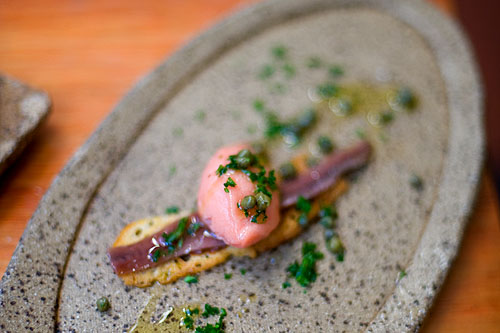
MoVida
1 Hosier Lane, Melbourne
03 9663 3038
www.movida.com.au
But perhaps the most satisfying meal of my visit was the absolute antithesis of upscale and took the form of a grubby Chinese restaurant in Footscray called 1+1 Dumpling Noodles. The restaurant, which Phil has previously written about, has a largely predictable northern Chinese menu, but with a few obscure but delicious Uighur/Western Chinese dishes thrown in. These included la mian, the famous Uighur dish of hand-pulled noodles fried with lamb, bell pepper and tomato (shown at the top of this post), spice-dusted lamb skewers, and a deliciously tart and crispy cucumber salad:
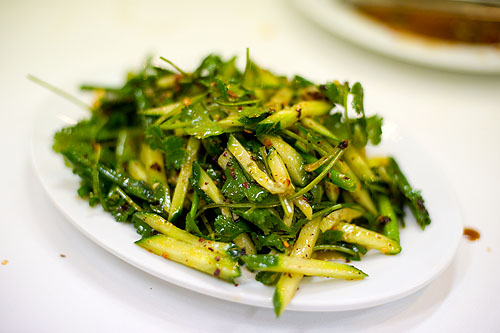
1+1 Dumpling Noodles
84 Hopkins Street, Footscray, Melbourne
03 9687 8988
Between meals it was constant stream of excellent coffee and much-missed Western baked goods. My favourite place for both was Pellegrini, an old-school 'espresso bar' that is considered by many emblematic of 1950's Melbourne. They also do a tasty apple strudel:
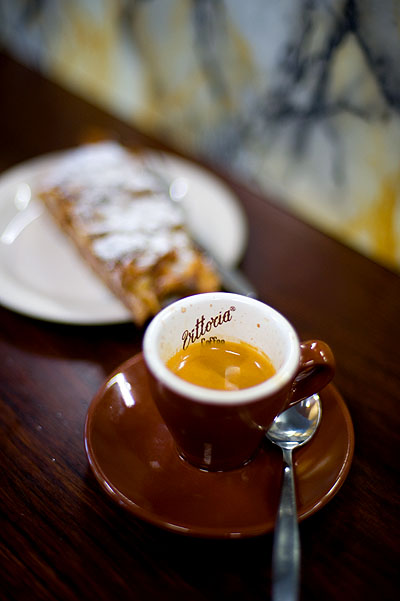
Pellegrini
66 Bourke Street, Melbourne
03 9662 1885
Slightly more refined pastries were available in the CBD:
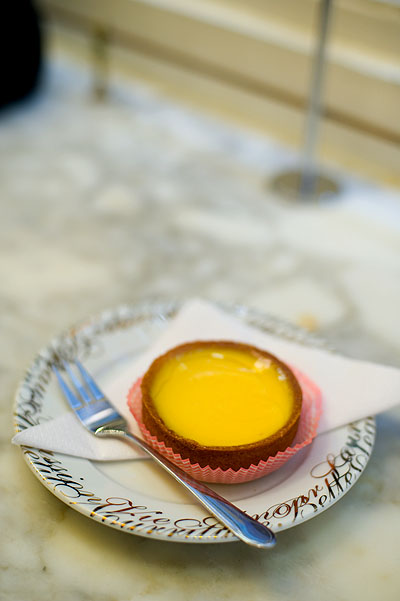
and Acland Street in St. Kilda had a string of cake shops that looked impressive, but that were mostly hit and miss in terms of flavour:
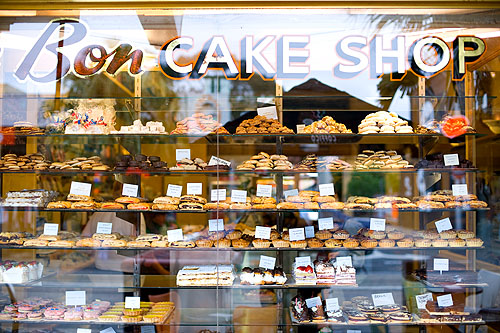
I particularly enjoyed the huge variety of tasty Greek and Turkish pastries:
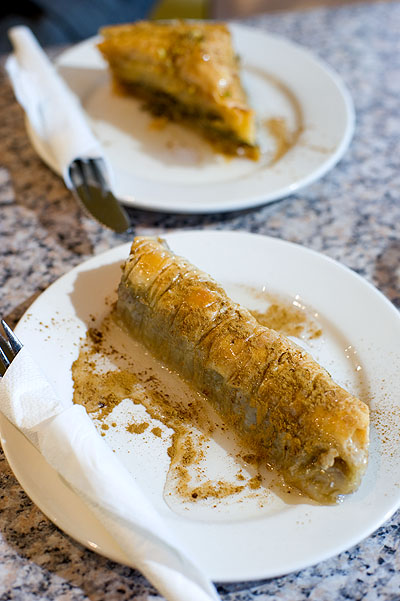
and of course, Aussie pies. The pie below was taken at Dinkum Pies, a rural Victoria bakery in the midst of upscale cafes on Block Place:
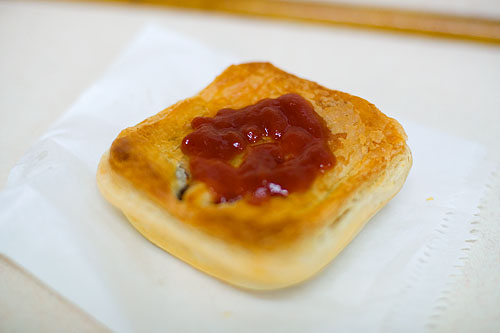
Dinkum Pies
29 Block Place, Melbourne
03 9654 6792
We spent a morning wandering around the halls of Victoria Market, with me drooling at the Mediterranean-style dishes I could never even dream of getting in Bangkok:

But this being Australia, we naturally settled on eating pies:
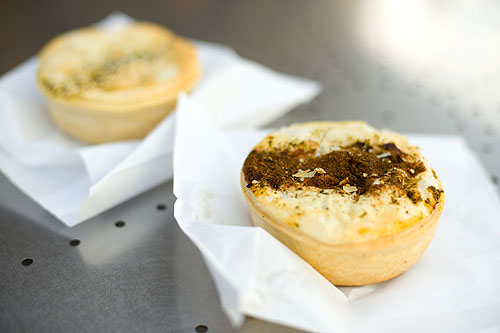
And for some reason I felt compelled to order a comically immense bratwurst:

A fittingly greedy end to what was essentially an indulgent but tasty visit.
 After a long hiatus, I find myself yet again spending quite a bit of time in Bangkok's Chinatown. This is mostly due to some photo assignments I'm working on, but I've also been making some eating trips as I now live only a couple metro stops away. As always, I've got my own repertoire of favourite stalls and dishes, but I'm also making an effort to discover some new places.
After a long hiatus, I find myself yet again spending quite a bit of time in Bangkok's Chinatown. This is mostly due to some photo assignments I'm working on, but I've also been making some eating trips as I now live only a couple metro stops away. As always, I've got my own repertoire of favourite stalls and dishes, but I'm also making an effort to discover some new places.












 I
I  I blog about phat Thai on occasion, but mostly for you people. I realize it's huge abroad, particularly in the US, but to be honest, I'm not such a big fan of the stuff. Generally find it kinda stodgy and greasy, particularly when compared to a lot of Thai food out here.
I blog about phat Thai on occasion, but mostly for you people. I realize it's huge abroad, particularly in the US, but to be honest, I'm not such a big fan of the stuff. Generally find it kinda stodgy and greasy, particularly when compared to a lot of Thai food out here.
 and happen upon a drunk Kiwi chef grilling chicken on the side of the street, don't be alarmed; foreigners haven't started taking menial jobs, and food standards haven't yet dropped that much. Rather, Hock and I simply wanted to make frango no churrasco, Portuguese-style grilled chicken.
and happen upon a drunk Kiwi chef grilling chicken on the side of the street, don't be alarmed; foreigners haven't started taking menial jobs, and food standards haven't yet dropped that much. Rather, Hock and I simply wanted to make frango no churrasco, Portuguese-style grilled chicken.

 Vegetarians, cover your eyes: this is a particularly flesh-laden post. But in its defense I'd have to say that Ko Tek Chiang 3 is one of the best uses of meat that I've encountered in a long time.
Vegetarians, cover your eyes: this is a particularly flesh-laden post. But in its defense I'd have to say that Ko Tek Chiang 3 is one of the best uses of meat that I've encountered in a long time.
 The name of this stall means 'rising flame', a reference to how the phat thai here is fried a small wok, which allows the flames to char the noodles. This is a substantial difference with the vast majority of phat thai, as the dish is generally made on a wide flat surface with no flames at all.
The name of this stall means 'rising flame', a reference to how the phat thai here is fried a small wok, which allows the flames to char the noodles. This is a substantial difference with the vast majority of phat thai, as the dish is generally made on a wide flat surface with no flames at all.
 Bangkok is a decent place to dip your toe in the ocean of regional Thai food, but as soon you attempt to go any deeper than that it's nigh impossible to find anything profoundly good (it's even getting harder to find really good Bangkok food these days, but that's a whole other blog post...).
Bangkok is a decent place to dip your toe in the ocean of regional Thai food, but as soon you attempt to go any deeper than that it's nigh impossible to find anything profoundly good (it's even getting harder to find really good Bangkok food these days, but that's a whole other blog post...).
 I've recently moved, and after all these years of living in Bangkok, I'm finally living in Bangkok. I'm now based steps from Thanon Silom, Bangkok's de facto financial district, basically in the centre of town. Foodwise, there's an amazing amount of cheap eats around here, strategically positioned and priced to appeal to low- and mid-level office staff. Frankly, much of it doesn't really look that interesting and is emblematic of the spicy, oily stuff that Bangkokians fancy these days. But amongst the riff raff there are a few 'famous' vendors, including a yen ta fo vendor called JC.
I've recently moved, and after all these years of living in Bangkok, I'm finally living in Bangkok. I'm now based steps from Thanon Silom, Bangkok's de facto financial district, basically in the centre of town. Foodwise, there's an amazing amount of cheap eats around here, strategically positioned and priced to appeal to low- and mid-level office staff. Frankly, much of it doesn't really look that interesting and is emblematic of the spicy, oily stuff that Bangkokians fancy these days. But amongst the riff raff there are a few 'famous' vendors, including a yen ta fo vendor called JC. I've
I've  It's the story of my life. Virtually every time I make specific plans to visit a specific restaurant in Bangkok, it's closed. It's happened tens of times, and I'm surprised I haven't mentioned it here before. And yes, it happened again today when I planned to take visiting Thai food fans Nick Malgieri and David Thompson to
It's the story of my life. Virtually every time I make specific plans to visit a specific restaurant in Bangkok, it's closed. It's happened tens of times, and I'm surprised I haven't mentioned it here before. And yes, it happened again today when I planned to take visiting Thai food fans Nick Malgieri and David Thompson to 




 I've
I've 



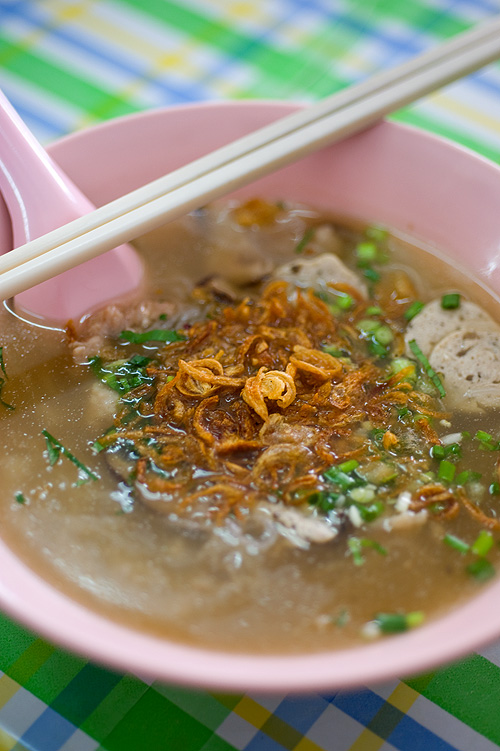 Khun Daeng, originally brought to my attention by diligent foodsleuth Nong A, is a tiny restaurant that serves an equally tiny repertoire of dishes. The emphasis is on kuay jap yuan, a noodle soup of partial Vietnamese origin that combines several kinds of pork including ribs, ground pork and muu yo, the smooth, peppery Vietnamese pork sausage. The nooodles used are made from rice flour and dusted with another type of flour, the latter of which provides the broth with a thick, slightly gelatinous texture. It's the kind of Vietnamese-Thai dish one finds in the towns along the Mekong River such as
Khun Daeng, originally brought to my attention by diligent foodsleuth Nong A, is a tiny restaurant that serves an equally tiny repertoire of dishes. The emphasis is on kuay jap yuan, a noodle soup of partial Vietnamese origin that combines several kinds of pork including ribs, ground pork and muu yo, the smooth, peppery Vietnamese pork sausage. The nooodles used are made from rice flour and dusted with another type of flour, the latter of which provides the broth with a thick, slightly gelatinous texture. It's the kind of Vietnamese-Thai dish one finds in the towns along the Mekong River such as  Last year I collaborated with pastry master-slash-writer
Last year I collaborated with pastry master-slash-writer  Khao San Road is probably the unlikeliest place in Bangkok you'd expect to find an authentic Thai cooking school. But the people behind Khao Cooking School have heaps of experience and have put together an institution that feels both professional and homey, despite the incongrous location.
Khao San Road is probably the unlikeliest place in Bangkok you'd expect to find an authentic Thai cooking school. But the people behind Khao Cooking School have heaps of experience and have put together an institution that feels both professional and homey, despite the incongrous location. In a good way, of course.
In a good way, of course.
















